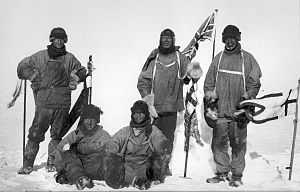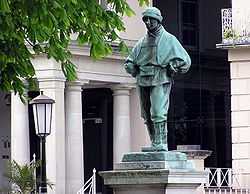Edward Adrian Wilson
| Edward Adrian Wilson | |
|---|---|
 Edward Adrian Wilson | |
| Born |
23 July 1872 Cheltenham, Gloucestershire, England |
| Died |
29 March 1912 (aged 39) Antarctica |
| Education | Cheltenham College, Gonville & Caius College, Cambridge |
| Occupation | Explorer |
| Spouse(s) | Oriana Souper (married 1901–1912) |
Edward Adrian Wilson FZS ("Uncle Bill") (23 July 1872 – 29 March 1912) was an English physician, polar explorer, natural historian, painter and ornithologist.
Early life
Born in Montpellier Terrace, Cheltenham, Gloucestershire, on 23 July 1872, Wilson was the second son and fifth child of physician Dr Edward Thomas Wilson (1832–1918) and his wife, Mary Agnes, née Whishaw (1841–1930).[1] A clever, sensitive, but boisterous boy, he developed a love of the countryside, natural history and drawing from an early age.[2] He was sent as a boarder to a preparatory school in Clifton, Bristol, but after failing to gain a scholarship to public school, he attended Cheltenham College for Boys as a day pupil.[3] His mother was a poultry breeder and he spent much of his youth at The Crippetts farm, Leckhampton near Cheltenham.[4] By the age of nine he had announced to his parents that he was going to become a naturalist.[5] With encouragement and tuition from his father, he started to draw pictures of the wildlife and fauna in the fields around the farm.[6] After passing his Oxford and Cambridge exams with honours in science, in 1891 he went to Gonville and Caius College, Cambridge where he read Natural Sciences, obtaining a first class degree in 1894.[7][8] It was during his time there that he developed the deep Christian faith and asceticism by which he lived his life.[9] He studied for his Bachelor of Medicine (M.B.) degree at St George's Hospital Medical School, London and undertook mission work in the slums of Battersea in his spare time.[10] In February 1898, shortly before qualifying as a doctor, Wilson became seriously ill and was diagnosed as having with pulmonary tuberculosis, contracted during his mission work.[11] During a long convalescence from this illness he spent months in Norway and Switzerland, time he used to practice and develop his skills as an artist.[12] He qualified in medicine in 1900 and the next year was appointed Junior House Surgeon at Cheltenham General Hospital.[13] He married Oriana Souper on 16 July 1901 just three weeks before setting off for the Antarctic as a member of Robert Falcon Scott's Discovery Expedition.[14]
Antarctica

Wilson took part in two British expeditions to Antarctica, the Discovery Expedition and the Terra Nova Expedition, both under the leadership of Scott.
Discovery Expedition
From 1901 to 1904, Wilson acted as Junior Surgeon, Zoologist and expedition artist, setting off with the expedition on 6 August 1901. They reached Antarctica in January 1902. On 2 November 1902, Wilson, Scott and Ernest Shackleton set off on a journey that, at the time, was the southern-most trek achieved by any explorer. The party had dogs but they were not experienced in using them and the food brought for the dogs had gone bad. With many of the dogs dead, they turned back on 31 December 1902 having reached latitude 82°17'S. They had travelled 300 miles farther south than anyone before them and were only 480 miles from the Pole. Shackleton was deteriorating rapidly, coughing blood and suffering fainting spells and unable to help pull the sledge. Scott and Wilson, themselves suffering, struggled to get the party home. It was a close call but 93 days after setting off, having covered 960 miles, they reached the Discovery and safety in February 1903. The following month, Shackleton, having suffered particularly badly from scurvy and exhaustion, was sent home early by Scott on the relief ship, Morning. On his return, Shackleton asked Wilson to join his Nimrod expedition to Antarctica in 1907, but partly out of loyalty to Scott, he declined.
Terra Nova Expedition
On 15 June 1910, Wilson set sail from Cardiff on the Terra Nova, as Chief of the Scientific Staff of Scott's final expedition. After making stops in Madeira, South Trinidad, South Africa, Australia and New Zealand, the Terra Nova was trapped for 3 weeks by pack ice, and finally arrived at Cape Evans in McMurdo Sound in early January 1911. A base camp hut was built and 3 weeks later work began to establish the supply depots in preparation for the journey to the South Pole the following austral spring. Deteriorating weather conditions and weak, unacclimatised ponies meant that the main supply point, One Ton Depot, was laid 35 miles (56 km) further north of its planned location at 80°S, something that was to prove critical during the return journey from the Pole the following year.


In the austral winter of 1911, Wilson led "The Winter Journey", a journey with Henry Robertson Bowers and Apsley Cherry-Garrard, to the Emperor penguin breeding grounds at Cape Crozier to collect eggs for scientific study. The 60 mile journey was made in almost total darkness, with temperatures reaching as low as −70 °F (−57 °C). Frozen and exhausted, they reached their goal only to be stopped by a blizzard during which their tent was ripped away and carried off by the wind, leaving the men trapped in their sleeping bags for a day and a half under a thickening drift of snow. When the winds subsided, by great fortune they found their tent lodged about half a mile away in rocks. Having successfully collected three eggs and desperately exhausted they returned to Cape Evans on 1 August 1911, five weeks after setting off. Cherry-Garrard later described this expedition in his memoir, The Worst Journey in the World.

On 1 November 1911, fourteen men set off from Cape Evans on the long trip to the South Pole. 79 days later, Wilson was one of the five-man Polar party that reached the Pole on 18 January 1912, only to find the pole had been claimed by Norwegian Roald Amundsen and his team just five weeks earlier.

Affectionately nicknamed 'Uncle Bill' by the men of the expedition, Wilson was the confidant of many, respected for his judgement, skills at mediation and dedication to others. By all accounts, Wilson was probably Scott's closest comrade of the expedition. Scott wrote "Words must always fail me when I talk of Bill Wilson. I believe he really is the finest character I ever met." When Scott's final camp was discovered by a search team in November 1912, Bowers and Wilson were found frozen in their sleeping bags. Scott's bag was open and his body partially out of his bag - his left arm was extended across Wilson.
At Gonville and Caius College the college's flag which Wilson took to the South Pole is preserved.
In media
In the film Scott of the Antarctic, Wilson was played by Harold Warrender. In the Central TV production 'The Last Place on Earth', Wilson was played by Stephen Moore. In the BBC Four production 'The Worst Journey in the World', Wilson was played by John Artur.
Memorials

In September 2013 the Cheltenham Art Gallery & Museum was renamed 'The Wilson' in his honour.[15]
Wilson's statue on the Promenade in Cheltenham, modelled by Scott's widow Kathleen, was unveiled on 9 July 1914 by Arctic explorer Sir Clements Markham.
The Edward Wilson Primary School in Paddington, London is named after him.
The students' cafe at St George's Hospital Medical School is named Eddie Wilson's.
See also
External links
| Wikimedia Commons has media related to Edward Wilson. |
| Wikisource has original works written by or about: |
- Cheltenhammuseum.org.uk, Portrait of Edward Wilson in the Cheltenham Town Museum
- Edwardwilson.com, Biography of Edward Wilson with a good number of his paintings and drawings
- Details of Edward Wilson material held at the National Marine Biological Library at the Marine Biological Association in Plymouth: http://www.mba.ac.uk/NMBL/archives/archives_personal/personal_papers.htm#wilsone
References
- ↑ Williams 2008, p. 17.
- ↑ Williams 2008, pp. 23-25.
- ↑ Williams 2008, pp. 25-26.
- ↑ Williams 2008, pp. 22,26.
- ↑ Williams 2008, p. 24.
- ↑ Williams 2008, p. 26.
- ↑ Williams 2008, pp. 28,30.
- ↑ "Wilson, Edward Adrian (WL891EA)". A Cambridge Alumni Database. University of Cambridge.
- ↑ Williams 2008, pp. 34-35.
- ↑ Williams 2008, pp. 41-48.
- ↑ Williams 2008, pp. 50-51.
- ↑ Williams 2008, pp. 52-56.
- ↑ Williams 2008, pp. 31,58-64.
- ↑ Williams 2008, pp. 69-70.
- ↑ "Cheltenham's Museum and Art Gallery renamed The Wilson". BBC News. 18 September 2013. Retrieved 18 September 2013.
- Williams, Isobel (2008). With Scott in the Antarctic : Edward Wilson - explorer, naturalist, artist. Stroud: History Press. ISBN 9780750948791.
|